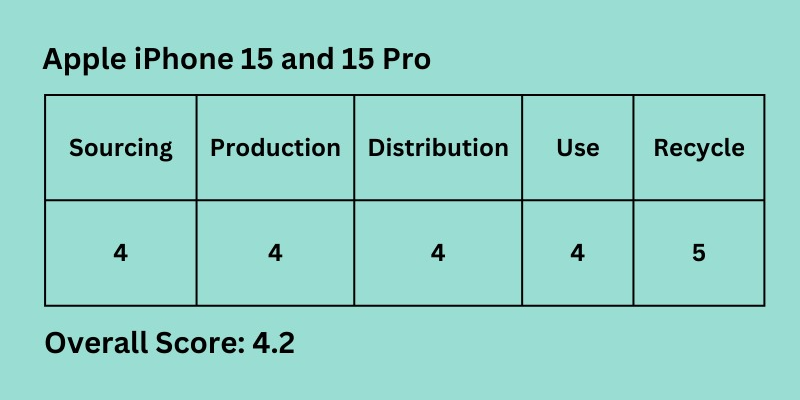Is your phone carbon neutral? In the crisp autumn of 2023, 85% of adults in Great Britain announced their commitment to combat environmental issues through lifestyle changes.
As the number of smartphone users climbs towards 5 billion globally, it’s high time we consider the impact of our tech choices on climate change and explore sustainable alternatives.
What makes a phone carbon-neutral?
Around 80% of a smartphone’s carbon footprint is generated during energy-intensive mining and manufacturing stages. Shockingly, each mobile phone is responsible for emitting around 55 kg of carbon emissions. Culminating 82.5 billion kg of carbon pollution worldwide.
Phone manufacturer’s divide their carbon footprint into five main stages to tackle carbon emissions in each phase.
Based on this criteria, we made our top sustainable phones ready to drop your carbon footprint.
Apple’s iPhone 15 series: Paving their way to be the most carbon neutral phones.
Carbon Emissions: 66 kg (from iPhone 15 Pro’s sustainability report)
When Apple releases a new phone, it’s not just about fancy features; it’s a commitment to green practices. The only downside? It might pinch your wallet.
Apple’s iPhone 15: Sourced with conscience, born to last.
iPhone 15 Pro and iPhone 15 Pro Max contains 20% recycled or renewable content, including 75% recycled aluminium in the enclosure. 20% of all material shipped in products in 2022 came from recycled and renewable sources.This reduces emissions by nearly 6% compared to previous models.
What’s the highlight this year?
iPhone 15 Pro and iPhone 15 Pro Max used 48% less energy than the energy conservation standard.
Used 100 percent recycled cobalt in the battery—a first for Apple.
This development is in line with Apple’s pledge from April 2023 to switch to entirely recycled cobalt in all their batteries by 2025.
Clean electricity
Apple is working with its suppliers to transition to 100% clean electricity for Apple production, demonstrating a commitment to reducing the environmental impact of its supply chain.
To reduce emissions from transporting products,
Apple uses lower-carbon non-air shipping modes, like ocean or rail. Partners with logistics providers with sustainability initiatives. And minimises packaging waste using recycled materials and smaller packaging boxes which we may not like, but mother nature loves it. This might also be the reason they stopped selling chargers!
Usage
There’s no need to talk about iPhone usage, they’re highly known for their long lasting hardware and can easily retain their value for a longer time when compared with Android phones.

Before we jump to the next, have you ever considered to partner with companies that are also carbon neutral? Check us out.
We’re on our mission to be carbon neutral whilst selling the best business phone plans with free dedicated support for your business. Now let’s get back to it.
Samsung S23 and the upcoming S24 Series: Innovative and genuinely putting in efforts to build carbon neutral phones.
Carbon Emission for S23’s life cycle: 58.8 CO2 kg (taken from Samsung’s product Sustainability report)
28% of the aluminium used is recovered scrap sourced from during the manufacturing processes and used in the volume keys, side key, and SIM card tray components on the side of the device.
Galaxy S23+ contains only 1.7% of plastic in terms of the total weight of packaging. Compared to Galaxy S7, the use of plastic in packaging for Galaxy S23+ is reduced by 96.8%.
Still not impressed? here’s some hot highlights that make Samsung shine in a carbon neutral world.
The Galaxy S23 series is made with RECYCLED OCEAN-BOUND PLASTIC.
Ocean-bound plastic is plastic waste of all sizes, including microplastics, mesoplastics, and macroplastics, found within 50 kilometres of coastlines in areas with inadequate or nonexistent waste management systems. This plastic waste is at high risk of entering the ocean and contributing to marine pollution.
For the internal components of the Galaxy S23+, 20% of the plastic parts come from this repurposed plastic sourced from discarded fishing nets and water barrels.
The Galaxy S23 Ultra series is primarily manufactured in Vietnam and South Korea.
These countries contribute to sustainability because of proximity to the supply chain making transportation more environment friendly.
Samsung’s energy-saving features are top-notch.
Power Saving Mode, Adaptive Power Saving, Adaptive Brightness, Quick Charge, Battery Optimisation, Deep Sleep Mode, and Always-On Display. These features help reduce power consumption, extend battery life, and minimise the carbon footprint of Samsung smartphones.
Samsung’s Galaxy S23 series not only comes with a five-year update guarantee that extends its lifespan, but also offers a recycling program and a trade-in option for customers who want to exchange their old Galaxy smartphones for a new one.
Source: https://www.samsung.com/global/sustainability/main/

Google Pixel 8 and 8 Pro: Google’s most Carbon Neutral Phone yet.
Carbon emissions: 79 kg
Third in the race is the latest Pixel 8 and 8 Pro made with 50% recycled aluminium.
Pixel 8 Pro is made with at least 18% recycled materials based on product weight The aluminum in the housing is 100% recycled content12 Pixel 8 Pro uses 100% recycled tin in the solder of all rigid and flexible printed circuit boards, including the main logic board, made at the final assembly site.
All Pixel products launched since 2020 use recycled materials. Google aims to use renewable materials in at least 50% of all plastic in its hardware products by 2025.
In 2022, Google reduced the amount of plastic in Pixel packaging by 97%. They also reduced the volume of packages by 54% and the weight by over 50%.
In terms of usage, Google takes the lead by announcing seven years of update, the only question now is whether people will stick to a google phone for that long. Trade in and recycling options are available.
And here’s why you should try this phone.

Fairphone 5: We saved the best for the last.
Fairphone is the most carbon neutral phone ever created up till now. The amazing part? Every component of this phone is repairable and can be bought from the website.
Fairphone’s goal is to make its phones completely circular, meaning that all materials used in the production of the phones can be recycled and reused.
Fairphone’s production partners are certified for their social and environmental standards. It works closely with its partners to improve its sustainability practices.
For instance, Fairphone partnered with afactory in China that implemented energy-saving measures and waste-reduction initiatives. Similarly, it partnered with a logistics provider that uses electric vehicles for deliveries in some cities.

If you’re in business, it’s time to think green. What are your plans? Let us know.
For further enquiries email us at info@initiis.co.uk
Give Your Business an Edge.





This Post Has 16 Comments
I do trust all of the concepts you’ve presented for your post. They are really convincing and can certainly work. Nonetheless, the posts are too brief for newbies. May just you please lengthen them a little from next time? Thanks for the post.
Thanks for the feedback! highly appreciate it. Will follow through.
Hi man, .This was a great post for such a tough topic to discuss. I look forward to reading many more great posts like this one. Thanks
I discovered your website site on google and check a couple of your early posts. Preserve in the top notch operate. I just extra up your Feed to my MSN News Reader. Looking for toward reading far more of your stuff afterwards!…
Hello There. I found your blog using msn. This is a really well written article. I will make sure to bookmark it and return to read more of your useful information. Thanks for the post. I will certainly comeback. que es el acne
Hey mate, .This was an excellent post for such a hard subject to talk about. I look forward to seeing many more excellent posts like this one. Thanks
As soon as the film starts, we’re introduced to what feels like a good dozen characters.
pleasant post, keep up with this interesting work. It really is good to know that this topic is being covered also on this web site so thank for taking time to discuss this!
I want assembling utile info, this post has got me even more info! .
A formidable share, I just given this onto a colleague who was doing just a little analysis on this. And he in reality purchased me breakfast as a result of I discovered it for him.. smile. So let me reword that: Thnx for the treat! But yeah Thnkx for spending the time to debate this, I really feel strongly about it and love reading extra on this topic. If potential, as you turn out to be expertise, would you mind updating your weblog with more particulars? It’s extremely useful for me. Big thumb up for this weblog submit!
Very well said, your blog says it all about that particular topic.*,**,
I am glad that I found this web blog, just the right info that I was looking for!
It?s actually a nice and helpful piece of info. I am satisfied that you shared this helpful info with us. Please stay us up to date like this. Thanks for sharing.
You have a very nice layout for your blog. i want it to use on my site too “
I am typically to writing a blog and that i actually appreciate your articles. The article has really peaks my interest. Im likely to bookmark your site and hold checking for brand spanking new information.
Thanks for the information provided! I was finding for this information for a long time, but I wasn’t able to find a reliable source.